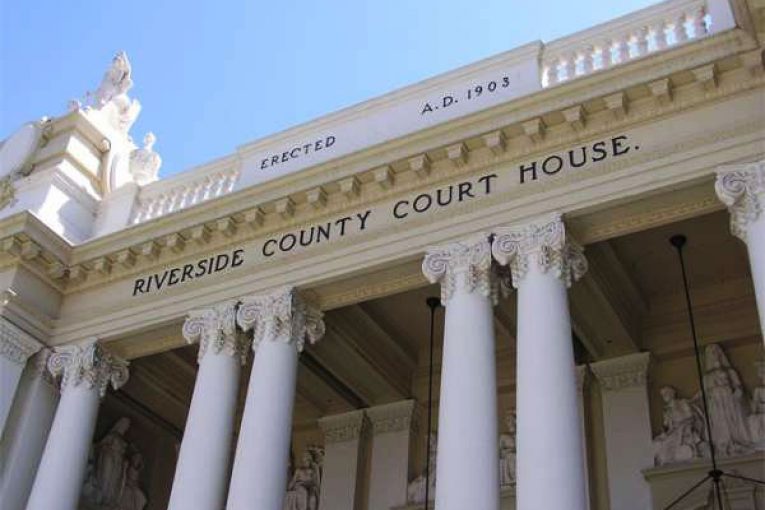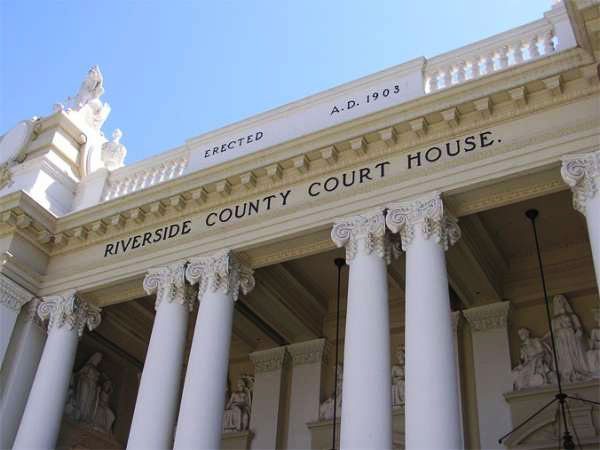

By Darling Gonzalez, Tommy Nguyen, and Michele Chadwick
RIVERSIDE, CA – The trial of Jose Larin-Garcia for the quadruple murder in Palm Springs resumed Thursday with more opinions from defense forensic consultant Randolph Beasley about what supposed inaccuracy of prosecution expert Craig Ogino’s interpretation of blood spatters found at the crime scene.
Larin-Garcia is accused of the murdering of four people (17-25 years old), who were found shot dead on the night of Feb. 3, 2019.
Expert witness Beasley is a crime scene analyst and reconstructionist, who has been added to the case by the defense to dispute Ogino’s initial discovery of bloodstain patterns.
Deputy District Attorney Samantha Paixao objected to the photographs of the blood spatters submitted by the defense yesterday, explaining that it is unclear “what substance was being used [for the discoveries], which is a problem.”
She requested that the witness lay the foundation for these findings in court under proper monitoring, stressing the importance of accuracy and integrity.
Defense Attorney John Dolan, while repeatedly explaining that he just wanted to “save court’s time,” decided to withdraw these photographs and proceed with the DDA’s protocol.
Dolan began the questioning by asking Beasley his knowledge about the standard interpretation of the amount of blood splatter found on the crime scene.
After that, Beasley began summarizing his findings and opinions on Ogino’s report of blood stain analysis, before expressing disagreements on certain parts, especially the stringing of different bloodstains on the Toyota, pointing out that “there were some inaccuracies.”
Dolan then asked the witness if there is any part on the report “where Mr. Ogino opined that the evidence was consistent with Mr. Larin-Garcia being the shooter.”
“[The question is] outside the scope of Mr. Ogino’s analysis,” DDA Paixao objected. “The bloodstain interpretation was his entire involvement in this case.”
Judge Anthony Villalobos ordered the court to take a short recess before clarifying DDA’s reasons for the objection.
Dolan explained his belief that during Ogino’s testimony, the interpreter had said that he believed the defendant to be the shooter, which is why Dolan wanted Beasley to also testify on that particular matter.
However, Judge Villalobos then clarified that Ogino has never testified on something like that besides the information about the locations of the blood spatters, expressing his agreement with DDA Paixao.
The questioning resumed as Dolan asked Beasley more questions regarding Ogino’s report, regarding the moving of the bodies during the murder.
It was not long until Judge Villalobos held another recess to address DDA Paixao’s objection against Beasley’s testimony. She was concerned that there was no effort of laying solid foundations for all opinions that the witness testified.
“We haven’t heard anything about his education, we have heard about some training that he has gone to, that he reviewed Ogino’s report and listened to his testimony,” DDA Paixao explained, “and now he is just offering his opinions with no basis for those opinions.”
Judge Villalobos was unsure if Beasley’s testimony was entirely opinions, therefore ordering the questioning to resume, assuming that the defense would get back to Beasley’s previous points and let him lay out the process of getting to those opinions.
When Dolan asked about the DNA evidence in the case, Beasley explained that it would have been valuable to have a lot more DNA analysis such as touch DNA for several different items of evidence that had not been tested.
“For me, as a crime scene analyst and a reconstructionist, I would want that information ideally to do a more comprehensive investigation on this case,” Beasley commented.
Defense attorney Dolan also questioned whether having moving bodies and a moving car created any issues for Beasley’s analysis.
Beasley responded that the movements did, in fact, create complications in his analysis as the collision could have interfered with impact patterns and blood splatter.
When discussing blood spatter in the crime scene, Beasley began to describe a notable impact spatter in the back of a gray t-shirt.
“I noticed on the back of a gray t-shirt that had been collected from Duarte-Rayas’ autopsy that on the backside of the t-shirt there was impact spatter and so that can, of course, help position where Mr. Duarte was and could definitely be a determining factor in knowing whose blood was splattered to determine a sequence of events for the shots that occurred,” Beasley explained.
After a short morning break, Dolan proceeded with his line of questioning by asking Beasley to describe his analysis of Larin-Garcia’s jacket when he examined it at the police station.
“My analysis was basically just confirming that there were blood stains in the sleeve areas of the jacket and what appeared to be an impact pattern of possible blood stains on the exterior left side of the jacket,” Beasley said.
Beasley also mentioned that the color of the stains were not a red-brown that he would usually see with blood.
Dolan later asked Beasley about the blood testing that was done on the jacket by crime scene analyst, Ogino.
Beasley stated, “I believe he did a presumptive test for blood using a hemostick and that is a color test to indicate that a stain, if it tests positive, actually could be blood. It is not a confirmation.”
Dolan then asked Beasley about his knowledge about the DNA swab testing that had been done on the area of the jacket that had been tested using the hemostick.
When Dolan asked about the result of the DNA test that had swabbed the jacket area, Beasley stated that the DNA test result was negative for blood.
Dolan later asked Beasley to explain his overall findings after his review of observations and viewing autopsy photos of the crime scene.
In his findings, Beasley said that based on the blood that he had observed on the passenger side mirror and a lot of other directional spatter stains on the passenger side of the vehicle, there needed to be more testing.
“I recommended that an experiment be done to determine the effect of blood being spattered from inside the vehicle out while it was moving and to see if some of those type directional spatter stains could be created as if they were the result of blood with the vehicle moving,” Beasley said.
Beasley later revealed that he had created a head as a replica for victim Duarte-Raya, showing the approximate trajectory as determined at the autopsy to help communicate his opinion about the shooter in the back seat.
Dolan then presented pictures of the autopsy photo of Duarte-Raya next to a picture of a head replica with trajectory rods that Beasley placed in approximate areas for gunshot wounds.
Dolan proceeded to ask Beasley if he could explain why he had made the Styrofoam heads with the trajectory rods.
“I think it would be the best way to have the jury understand this evidence, and especially in understanding that photographs can be deceptive when you have trajectory rods because of the relative position the camera may have taken the photographs,” Beasley explained.
The defense asked the court to review People vs. Nelson and People vs. Jones “because the People are consistently making objections regarding speculation,” Dolan continued, “They both stand for the proposition that expert opinions are not speculation. They are the opinions of experts.”
Beasley then continued to testify. He testified that “the purpose of the demonstration was to confirm that three people could be in the rear seat of the Toyota and whether or not it would be most consistent with the shooter being in the middle position.”
However, as his testimony continued, the DA continued to object to speculation and improper foundation.
Judge Villalobos sustained the majority of these objections. Regarding his decisions on objections, he said, “I was very specific as to whether that is something the jury needs to decide and the expert can’t say whether this person did that specifically or not.”






